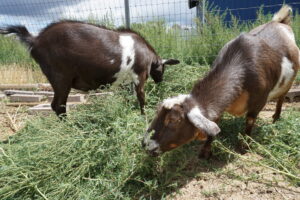
This morning, the ground was still soaked with rain water from the previous night’s storm when I went outside to let my goats and chickens out of their enclosures and into their respective yards. The weeds (mostly kochia, an invasive species in this area) have grown tall and hearty with the onset of the seasonal rains, and many plants—now close to my height—are growing in or adjacent to the path, making accessing these enclosures a challenge. As often happens when I am beset by this sort of inconvenience, I made a plan to pull weeds and toss them into the enclosures for the animals to munch on each time I go out to care for them.
The plans I come up with early in the morning when something is of immediate concern to me, though, fall apart as surely as spilled pellets of chicken feed melt in the rain, and so we are (again this year) the house in the neighborhood with the obscenely tall weeds—or at least the weeds so tall that if anything obscene was happening among them, a neighbor would be hard-pressed to observe it. The obvious solutions to these challenges—mowing or spraying poison—both work against my ultimate aim for the property, which is for its empty spaces to be filled with wild, native plants. Mowing would knock down all plants indiscriminately, and spraying the area’s favored herbicide would mean killing a number of “weeds” that are exactly the plants I desire to cultivate, not to mention allowing plant poison to build up in the soil around where I am trying to grow food. That leaves pulling and replacing with native seeds, a labor intensive practice that we struggle to implement effectively on such a large property.
The neighbor who shares the largest stretch of fence line with me is an advocate for herbicide. He insists that it will only kill the plants one doesn’t want, leaving the ones one does, which I expect is true if what one wants is a vast monoculture of grass. Although he and his partner are kind to me and mine, I suspect we are a nuisance to him for our lack of adequate weed control measures. He keeps mules who are tempted by the plants growing across the fence, and so he sprays poison a good 3 feet across the fence line to deter them from reaching through. This is a compromise that works for me—I allow the neighbor to encroach ever so slightly onto my land with a substance I’d rather not be anywhere near, and he doesn’t bother me about my terrible lack of weed control everywhere else.
Still, I wonder if this couple sits at home complaining about my unkempt property the way my husband and I complain about the noise, garbage, and lack of animal control practiced by another set of neighbors we share a fence line with. It is funny to feel simultaneously like a terrible neighbor for keeping a bit of a messy property and a great one for being relatively quiet and unobtrusive.
In reflecting on what type of neighbor I am and how I am perceived by those living in my immediate vicinity, I wonder what actually makes a good neighbor. The conflicts between me and my two neighbors come largely down to being considerate—it would be more considerate of me to more carefully manage the weeds along the fence where the neighbor’s animals might try to access them, and it would be more considerate of my other neighbors to keep their animals enclosed and their music to a reasonable level. Being considerate, though, feels like more of a baseline for coexistence rather than a marker of goodness. After all, we do share a fence with a third set of neighbors who keep pretty much entirely to themselves. I don’t think of them as “good” so much as “absent.”
To cross over into being a truly good neighbor, I think one must have a positive impact on the area and the people who live within it. This can be done through small actions—lending tools, caring briefly for pets, purchasing neighborhood kids’ fundraising products, sharing in the maintenance of communal areas, or sheltering packages from the elements—or through large actions like organizing community events or advocating for better neighborhood conditions.
Most of my neighborly-style efforts toward “goodness” take place outside of my immediate locale. I spend the energy I have available trading food and goods with friends, participating in local community writing-events, and promoting workshops and businesses that are helping grow the local food economy. In short, I try to be as good of a community member as I can be, and as a result, my standing as a neighbor fluctuates somewhere between absent and neglectful.
I tell myself that this is okay—the world is hard and we’re all doing the best we can, right? But letting myself off the hook in this way still feels so deeply unsatisfying. It’s not that I think I should be harder on myself or just push through and make good neighboring a priority regardless of the toll it takes. Rather, it feels to me like it takes an awful lot to be a good citizen, community member, neighbor, friend, partner, family member, and person in the world as it is. Ideally, we would all spend more time reflecting on why that is and what we can do about it. With so many drains on our energy resources, though, I’m not sure how to pull it off.
Maybe the key is to tackle both simultaneously by throwing a few weed pulling and social activism planning parties. Participants could build community while tearing down unwanted plants or doing other important chores. Laundry and lobbying? Dishes and dissent? Whatever the answer, I don’t think we’re going to find it alone. Making things better for everyone necessarily involves collaborating, communicating, and helping with each other’s burdens—a “pulling together,” if you will, to bring about camaraderie and meaningful change.

